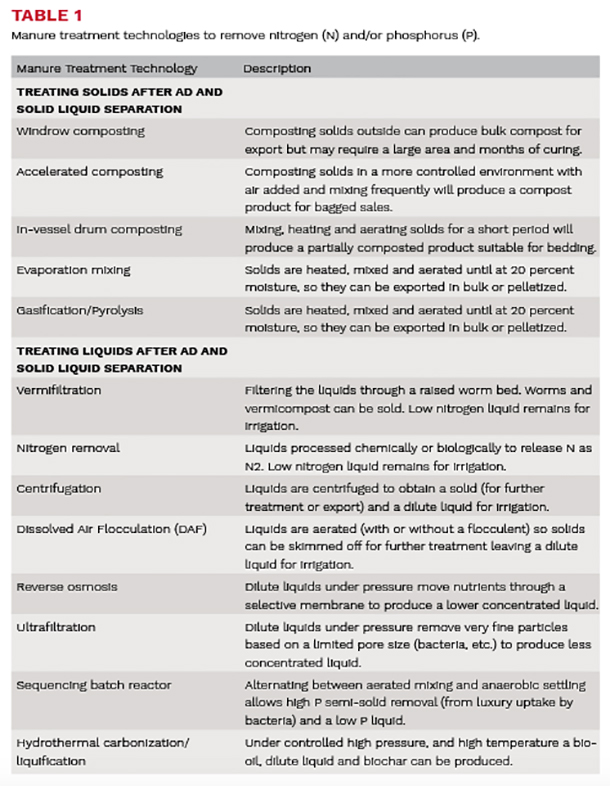Public policy is increasingly evolving to reduce or divert waste from limited landfill space. One way to accomplish this is by reducing the many tons of organic waste such as food processing waste, food scraps, and spoiled fruits and vegetables that are landfilled annually.
These materials have nutrients and organic matter that can be beneficial to farms when managed properly. Dairy farms are used to handling large volumes of manure, and they have equipment and expertise that could be useful to manage organic material diverted from landfills. So what are the options for dairy farms?
Dairy farms may have more opportunities to take organic materials diverted from landfills in the future. This food waste may benefit the farm by providing organic solids as soil amendments, nutrients (if needed on the farm), and energy if fed through an anaerobic digestion (AD) system. The tipping fees that accompany the food waste may provide a revenue stream for the farm, but there will likely be extra equipment, labor, and structural costs, as well as management time to properly handle these materials.
Before planning to take food wastes, the farm should examine their manure handling system and nutrient management plan (NMP) to determine the impact of additional volume and nutrients, and if they have enough land for sound nutrient recycling. There are advanced manure treatment technologies that may enable excess nutrients to be removed and or exported off the farm if adequate land base is not available to recycle the nutrients according to a nutrient management plan.
Diverting food waste and other organics from landfills saves space in the landfills and also reduces the potential release of methane as the organic material degrades in the landfills. Many landfill operations have systems to capture the biogas produced and either flare it or convert it to renewable energy by generating electricity through an engine generator or cleaning the biogas to upgrade it to pipeline quality and selling it as renewable natural gas (RNG).
There is quite a variety of potential organic material that may be offered to farms for recycling and each source needs to be evaluated for its handling requirements and impact on the farm system. Food waste from food processing plants will generally be delivered in bulk. If these materials have a high liquid content, handling and storage will need to be carefully managed if the liquid cannot be contained because runoff to streams can be problematic. The concentration of volatile solids (VS) (that can be converted to biogas in an AD) and nutrients may vary depending on the source and dilution water. Because of the dilution that occurs, any cleaning chemicals will likely not be a concern.
Rejected food products that have expired, don’t meet standards, or have been recalled, will typically have a consistent nutrient content but will need to be de-packaged. There are de-packaging machines. Post-consumer organic wastes will also vary in content (depending on menu changes) but may be provided more consistently, although still may change as attendance changes in schools or the hospitality industry. Post-consumer products very likely will also have sorting problems where non-organic materials have been inadvertently included.
The farm can expect an added revenue stream from food waste. Tipping fees for food waste can be considerable as landfilling may be prohibited or landfill tipping fees may be high. If the food waste can be added to an anaerobic digester there will be substantially increased biogas production depending on the food waste source. Food waste typically contains much more biodegradable VS (that are converted to methane) than manure.
Using food waste residue in a nutrient management plan takes careful management. The nitrogen and phosphorous in food waste may be more readily available than the nutrients from manure. The carbon in food waste will typically also degrade faster than manure. Building organic matter in soils with food waste may not occur to the degree you may want.
There are detriments to importing food wastes, besides the potential packaging from post-processed waste and incidental trash items mixed with post-consumer waste. Think about how confusing it is at events or retail locations when there are three different bins for you to toss things into after a meal. The additional mass and additional nutrients will need to be incorporated into your farm’s manure system and your NMP. The extra volume will fill storage space so either more storage will be needed or the storage period will be reduced. Extra volume means an increase in spreading costs (extra labor, equipment, and energy use need to be considered as well). If it costs one cent a gallon to truck to the farthest fields and you get seven cents a gallon tipping fee, your net is reduced.
The nutrients recycled back to the land need to be balanced. A high-phosphorous (P) food waste may push the farm out of a balance for P. Having a NMP that accounts for the additional nutrients will help protect the environment while satisfying both regulators and concerned neighbors. Farms with a CAFO permit must account for these nutrient sources in their nutrient management plans. Certainly there can be adjustments to the NMP. Cropping more land that will be able to receive the added nutrients, increasing yields, double-cropping to take up more nutrients or exporting the nutrients are all possibilities.
Added revenues from the importation of food waste may improve the opportunity to use advanced manure treatment technology to reduce mass and nutrients. AD will only reduce the mass of the volatile solids (VS) that is biodegraded, leaving most of the processed digestate with all of the nutrients to be dealt with. AD will create a homogeneous liquid that will be easier as a consistent liquid to further treat.
Table 1 shows a number of manure treatment technologies to remove nitrogen (N) and/or phosphorus (P) with a brief description. The table assumes that the co-digested manure has gone through an anaerobic digester and a solid liquid separator.

The capital and operating costs of each of these advanced manure treatment technologies need to be evaluated with a partial budget including the value of the tipping fees, reduced transportation costs, and any by-product sales. Fact sheets on advanced manure technology are available on the manure treatment section of the PRO-DAIRY website (Cornell CALS - Manure management).
Pete Wright, Karl Czymmek, and Tim Terry are specialists with Cornell CALS PRO-DAIRY.
This article appeared in PRO-DAIRY’s The Manager in March 2021. To learn more about Cornell CALS PRO-DAIRY program, visit PRO-DAIRY Cornell CALS.







